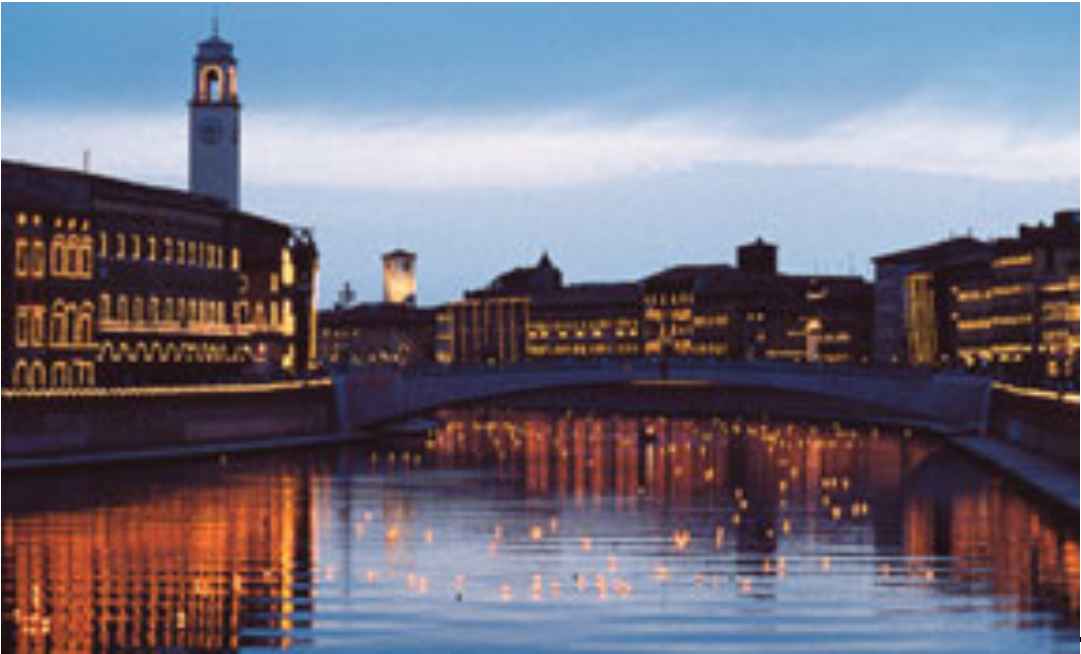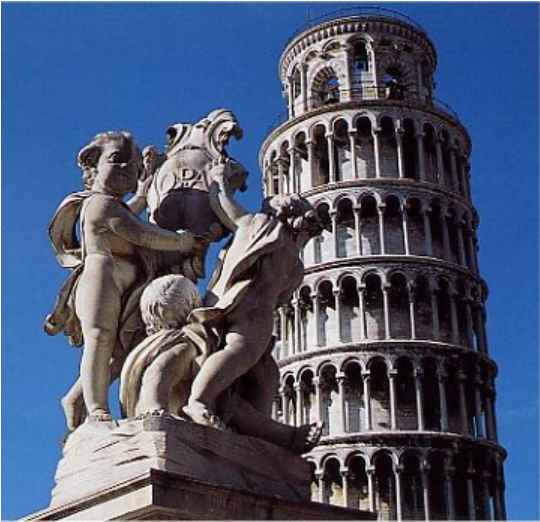Pisa, Italy
Pisa
is a relatively small town (about 100,000 inhabitants), located near
the Tyrrhenian Sea (11 km) in north-western Tuscany, along the banks of
the Arno river, and approximately 80 km west of Florence. Worldwide known
for the extraordinary monument of the Leaning Tower,
exalting the quadrilogy of the “Piazza dei Miracoli”, Pisa can boast a
millenary history whose point of highest splendor dates back to the age of
Maritime Republics.
 It
is a casket of artistic treasures in which Romanesque and Gothic churches,
squares and palaces all extol its quarters traced out by the “Lungarni”
and by the ancient streets. As an important University town,
it has been able to hold its prominent position thanks to its several
Faculties and to the "Normale"
superior school situated in the “Piazza dei Cavalieri”. The visitor to
Pisa will discover not only art, culture and history, but also natural
environment like the park of Migliarino San Rossore, the Litoral and the
Monte Pisano, forming a particular evocative frame around it.
The Symposium will be held at the University Conference Centre,
in downtown Pisa. It
is a casket of artistic treasures in which Romanesque and Gothic churches,
squares and palaces all extol its quarters traced out by the “Lungarni”
and by the ancient streets. As an important University town,
it has been able to hold its prominent position thanks to its several
Faculties and to the "Normale"
superior school situated in the “Piazza dei Cavalieri”. The visitor to
Pisa will discover not only art, culture and history, but also natural
environment like the park of Migliarino San Rossore, the Litoral and the
Monte Pisano, forming a particular evocative frame around it.
The Symposium will be held at the University Conference Centre,
in downtown Pisa.
Tourist Attraction
The most famous attraction is the
Tower of Pisa, the bell tower of the
Cathedral. Its construction began in the august of 1173 and continued
(with two long interruptions) for about two hundred years, in full
fidelity to the original project, whose architect is still uncertain. In
the past it was widely believed that the inclination of the Tower was part
of the project ever since its beginning, but now we know that it is not
so. The Tower was designed to be "vertical" (and even if it did not lean
it would still be one of the most remarkable
bell towers in Europe), and started to incline during its construction.
 Both
because of its inclination, and its beauty, from 1173 up to the present
the Tower has been the object of very special attention. During its
construction efforts were made to halt the incipient inclination through
the use of special construction devices; later columns and other damaged
parts were substituted in more than one occasion; today, interventions are
being carried out within the sub-soil in order to
significantly reduce the inclination and to make sure that Tower will have
a long life. In this entire story it is possible to find a meaningful
constant, the "genetic code" of the Tower: its continual interaction with
the soil on which it was built. Both
because of its inclination, and its beauty, from 1173 up to the present
the Tower has been the object of very special attention. During its
construction efforts were made to halt the incipient inclination through
the use of special construction devices; later columns and other damaged
parts were substituted in more than one occasion; today, interventions are
being carried out within the sub-soil in order to
significantly reduce the inclination and to make sure that Tower will have
a long life. In this entire story it is possible to find a meaningful
constant, the "genetic code" of the Tower: its continual interaction with
the soil on which it was built.
 Today's
(2001) works for the safeguard and the conservation of the Tower with very
advanced methodologies are designed to fully respect this constant.
Moreover there are several and various type museum in Pisa (medical,
historical, art, natural, etc), the botanic garden, the church of
“Santa Maria della Spina”,
The Tower of Santa Maria, The Guelph Tower of the
Citadel, The Roman Ships of Pisa etc. Last but not the least the regional
park of Migliarino, San Rossore, Massaciuccoli that was established
in 1979, it extends for over 20,000 hectares located along the coast from
Viareggio and Livorno. At the center of an area strongly urbanized,
this territory has maintained notably natural characters, where it is
found one of the rare examples of non buildable coast area. Today's
(2001) works for the safeguard and the conservation of the Tower with very
advanced methodologies are designed to fully respect this constant.
Moreover there are several and various type museum in Pisa (medical,
historical, art, natural, etc), the botanic garden, the church of
“Santa Maria della Spina”,
The Tower of Santa Maria, The Guelph Tower of the
Citadel, The Roman Ships of Pisa etc. Last but not the least the regional
park of Migliarino, San Rossore, Massaciuccoli that was established
in 1979, it extends for over 20,000 hectares located along the coast from
Viareggio and Livorno. At the center of an area strongly urbanized,
this territory has maintained notably natural characters, where it is
found one of the rare examples of non buildable coast area.
|

